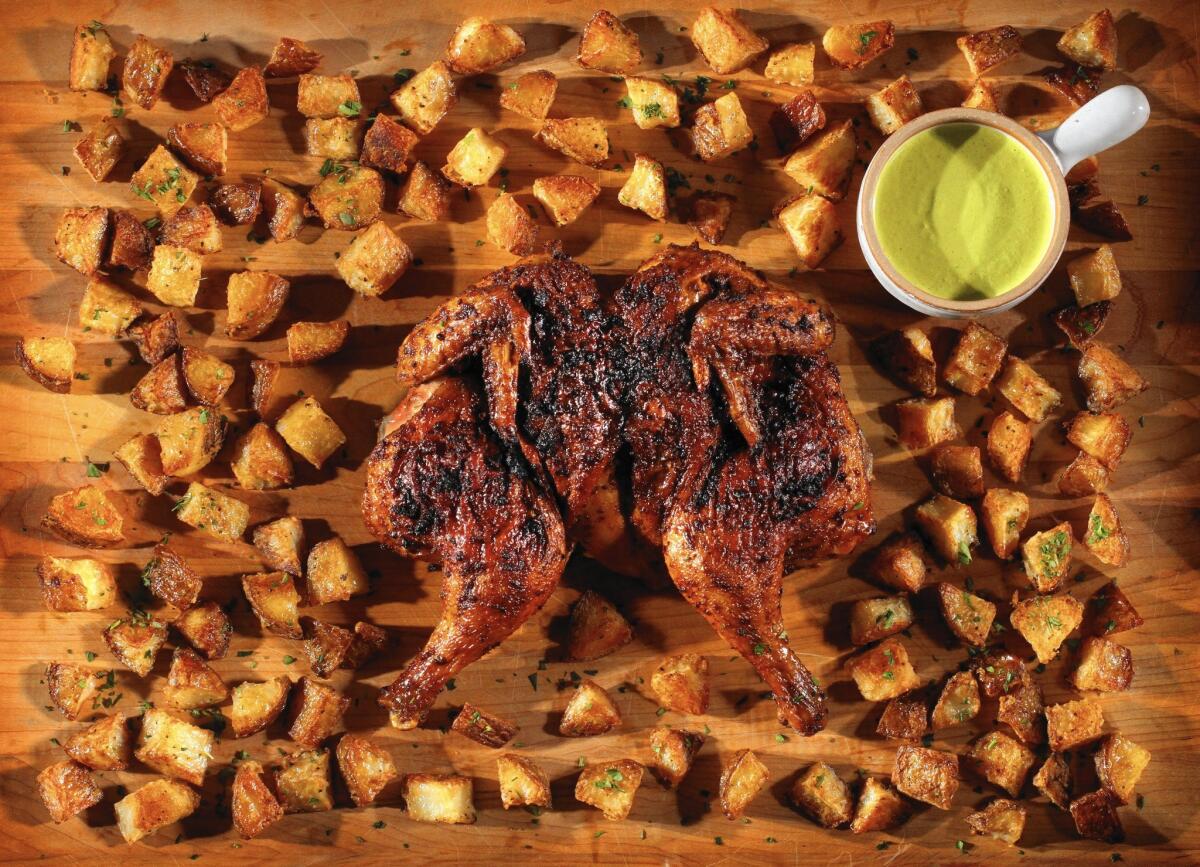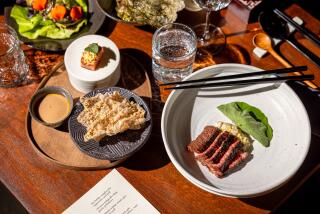In ‘The Food Lab,’ J. Kenji López-Alt turns kitchen scientist

Peruvian-style roast chicken with jalapeño salsa is one of hundreds of recipes in “The Food Lab.”
- Share via
It wasn’t so long ago that we learned to cook from an authority figure — our mother, our boss, Julia. They showed us how to do something, and we simply did it — without asking questions, much less demanding answers. But these days, the thirst for explanation is bottomless, either to help in actual cooking or to use as ammunition in online arguments.
Stepping into the fray this month is J. Kenji López-Alt, whose new book, “The Food Lab” (W.W. Norton), is a lavishly illustrated, 950-page, 61/2 -pound exploration of how science works in cooking that’s sure to be one of the big books of the fall cookbook season.
López-Alt will already be familiar to many of his book buyers. After graduating from MIT (with a degree in architecture), he worked at Christopher Kimball’s Cook’s Illustrated magazine, the monthly missal for the explanation-obsessed. For the last six years, he’s been the author of the popular Food Lab column on the Serious Eats website, billed as “unravelling the mysteries of home cooking through science.” The book is a compilation of those columns, plus lots of new material.
SIGN UP for the free In the Kitchen newsletter >>
“The Food Lab” is loaded with fascinating information, all of it pegged directly to explaining how the basic processes of cooking work. This is an important distinction, as kitchen science is most valuable when it’s rooted in practice. (Full disclosure: I’m intimately aware of the pitfalls involved because in 2001 I published a book on kitchen science called “How to Read a French Fry,” which López-Alt generously credits in his acknowledgments.)
“The Food Lab” falls somewhere between the pure science of Harold McGee’s elegant essays in “On Food and Cooking” and the geeky excursions in Nathan Myhrvold’s “Modernist Cuisine.” López-Alt gives you enough science for the explanations to make sense, but everything is still firmly rooted in practical home cooking. While it could be read straight through, thanks to López-Alt’s breezy conversational style, it’s probably most helpful when you want to learn about a specific topic — eggs, stocks, pastas, etc.
Maybe the most valuable thing science can contribute to cooking is its method of inquiry — theories are worthless if they can’t be verified through testing. This is where “The Food Lab” really shines, when in addition to offering the theoretical explanation of what’s happening, López-Alt grounds his findings in experiments he’s carried out. When should you salt a steak? López-Alt tested half a dozen different timings and found that salting either an hour before or just before cooking was best. Any time in between and the salt drew moisture to the surface that hindered the browning.
When do you salt a hamburger? Or a sausage? It turns out the answers are different because the desired results are too. López-Alt found that you want a looser, more crumbly texture for a hamburger, so you’re better off salting just the outside of the formed patty right before cooking — salting earlier will create protein linkages that will turn the burger dense. You prefer that kind of texture in a sausage, however, so you salt earlier. To better make his point, López-Alt dropped a Dutch oven on each hamburger sample and observed how it splattered. Science does not need to be dull.
Granted, the search for the perfect cooking technique sometimes leads to unnecessary “MacGyver-ing” — torturing a process so a simple task winds up being needlessly complicated. To hard-boil an egg, López-Alt drops it into boiling water for 30 seconds, adds ice cubes to stop the boiling, returns the water to exactly 190 degrees and then cooks for 11 minutes.
But that’s not unexpected in this kind of book, and it may even be desirable — Cook’s Illustrated has built a million subscribers doing just that kind of thing, month after month.
The book is also studded with hundreds of recipes, mostly of the gastro-pubby sorts of dishes that adapt so well to the home kitchen. There is a lot of ground beef (sausages, hamburgers, meatloaf), but there are very few trips into molecular cooking (sous-vide is limited to what can be done in an ice chest, and you’ll find nary a trace of exotic thickeners here).
RECIPES: Peruvian-style roast chicken with spicy jalapeño sauce | Super-crisp roasted potatoes
The Peruvian-style roasted chicken was terrific (rubbed with spices, spatchcocked and cooked at high temperature to get a really crisp skin). Even better was López-Alt’s simple technique for crisp roasted potatoes. He uses bakers rather than boilers (the starch structure cooks up lighter), simmers them until they’re almost tender, then tosses them in a pan with fat to coat and to rough up the cut edges (to set up the best crust). After roasting at 450 degrees for an hour, these were the crispest, lightest roasted potatoes I’d ever made.
It may be, as he says, just a matter of building up a coating of dehydrated gelatinized starch, but these potatoes were seriously delicious. Which is, after all, the whole point.
::
21 cooking tips from J. Kenji López-Alt’s “The Food Lab”
To make perfect poached eggs, put the raw egg in a strainer and let the loose part of the whites drip through, then lower the strainer into simmering water and hold it for a minute to let the white set up before tilting the egg out into the water to finish cooking.
Salting eggs 15 minutes before cooking yields the least watery, most tender scrambled eggs.
Make a quick stock by combining chopped chicken parts and unflavored gelatin to give it body.
Speed the caramelization of onions by adding a little sugar (1 tablespoon) and a little baking powder (1/4 teaspoon) for every 5 pounds of onions.
Boost the umami of meat dishes with Worcestershire sauce, Parmigiano-Reggiano, dashi, soy sauce or other glutamates; using multiple sources is much more effective than adding just one.
When braising meat, leave the lid off — the temperature will be 10 to 20 degrees lower, keeping the simmer more gentle.
Salt steaks immediately before cooking, or a full 40 to 50 minutes before. In between, there will be moisture pulled to the surface that will inhibit browning and crust formation.
Tempering steaks by bringing them to room temperature before cooking doesn’t work. Steaks warm far too slowly to make a difference.
Blanching vegetables in large pots of water keeps their colors bright.
For the best, crumbly texture, don’t salt ground meat until after the patties have been formed.
The opposite is true for sausages, which you want to be smoother. In fact, salting cubes of meat for sausage two hours before grinding and cooking saves half the juices that would have been lost if you’d ground and cooked right away.
Replace ground veal in meatloaf with powdered gelatin for the same moist texture.
Pressing burgers flat on the griddle while they’re cooking is perfectly acceptable and even desirable — as long as you want a thinner burger and you restrict your pressing to the first 30 seconds.
Roasting beef on the bone does not make it any more flavorful, but the insulation the bone provides keeps the meat a little juicier.
For the best roast beef, cook it low and slow to the desired doneness, then after the meat has rested, pop the roast back into a very hot oven to brown. The same is true for pork shoulder.
Gradually adding liquid to a roux results in smoother sauce than adding it all at once.
Beating olive oil for a vinaigrette or mayonnaise in a blender or food processor can make the oil taste bitter. It’s better to start the dressing with a neutral oil and add olive oil at the end for flavor.
Potatoes cooked in water with vinegar added will hold their shape better than potatoes cooked in plain water.
Adding a little old oil to fresh will result in better frying. But just a little — too much old oil (or oil that’s been used too long), and the smoking point will drop.
A hotter temperature does not keep fried food from absorbing more oil. In fact, the opposite is true. But it does make food seem like it’s absorbed less oil by making the surface crisp and light.
Bread chicken immediately before frying to keep the crust crisp and light.
ALSO:
How to make a Sqirl’s super trendy grain bowl with chef Jessica Koslow
Want to know what the summer sun tastes like? Try this twist on traditional gazpacho
5 Questions: Cookbook author Amelia Saltsman is chill with Jewish and farmers market heritages
More to Read
Eat your way across L.A.
Get our weekly Tasting Notes newsletter for reviews, news and more.
You may occasionally receive promotional content from the Los Angeles Times.









